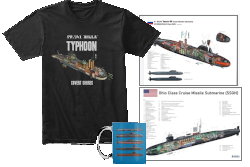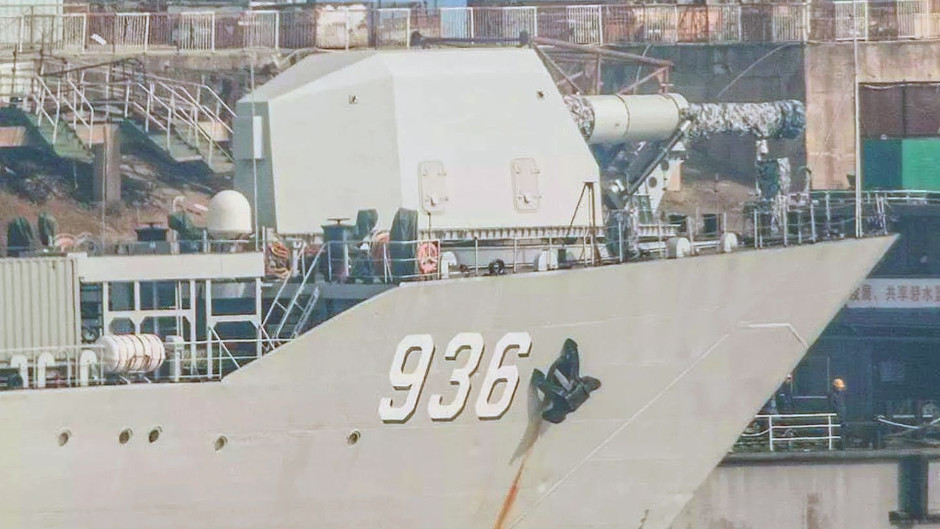
Chinese Navy Rail Gun
Covert Shores Guide: World Navy's Rail Gun Projects


 With the US Navy's recent step-back from putting Electromagnetic Railguns (EMRG) on warships raises questions on the much vaunted technology. The Navy’s FY2021 budget submission did not request funding for EMRG in FY2022-FY2025.
With the US Navy's recent step-back from putting Electromagnetic Railguns (EMRG) on warships raises questions on the much vaunted technology. The Navy’s FY2021 budget submission did not request funding for EMRG in FY2022-FY2025.
The death knell for he US Navy's EMRG seems to be very prosaic. According to a report to the US Congress on Feb 26:
As the Navy was developing EMRG, it realized that the guided projectile being developed for EMRG could also be fired from powder guns, including 5-inch guns on Navy cruisers and destroyers and 155 mm artillery guns operated by the Army and Marine Corps. The concept of firing the projectile from powder guns is referred to as GLGP and HVP. One potential advantage of HVP/GLGP is that, once developed, it can be rapidly deployed on Navy cruisers and destroyers and in Army and Marine Corps artillery units, because the powder guns in question already exist.
However the US Navy was not alone in developing RailGun technology. China and Turkey are also actively developing systems.
If China, or Turkey, deploys rail guns operationally we are likely to see years of debate over whether the US Navy has taken the correct route. There may be a tendency to dismiss them as flawed because, if the US Navy didn't invest further then they must be a bad idea. We should be cautious of letting any national perspectives cloud our judgement.
THE book on Special Forces subs Covert Shores 2nd Edition. A world history of naval Special Forces, their missions and their specialist vehicles. SEALs, SBS, COMSUBIN, Sh-13, Spetsnaz, Kampfschwimmers, Commando Hubert, 4RR and many more.
Check it out on Amazon
There are a lot of reasons for navy's to be interested in EM RailGuns. They offer very long range fire support, relative to traditional naval guns. The new ranges are in the order of 100 nautical miles, which is 5 or more times current naval guns. And because of their higher projectile speeds they are able to get the round on target much quicker than missile systems. This fills the much desired Time Critical Strike role. All the while the greater range reduces the vulnerability of the warship to counter-fire (unless the enemy too has rail guns).
Instead of using an explosive charge to propel the projectile, an electromagnetic force is used. And because the projectile is so fast, there is little point in giving it an explosive warhead. This complete elimination of high explosive propellant and warheads simplifies resupply. It should also be safer to store and handle.
All the time the simple nature of the rounds should mean that it is much cheaper than missiles, and also many more can be carried.
RailGuns are also being proposed for missile defense and, logically, could augment missiles in the anti-air role.
So why are we not seeing Rail Guns in service on warships around the world. Well it is new technology, and development hasn't been that fast. The systems need a massive amount of power, which is viable on a warship, but requires substantial modifications if it is to be retrofitted.
Additionally RailGuns face many competing ideas. High energy lasers (HEL), new cruise missiles, hypersonic boost-glide missiles and gun-launched extended range munitions. Many have questyioned whether RailGuns are worth it in this context.
However there are several projects underway, and we might soon see them aboard some nations' warships. China would be the safest bet at this point.
US Navy: BAE Systems EM Railgun
 The US Navy's Electromagnetic Railgun (EM Railgun) was developed by BAE Systems. Development started in 2005 and the system fired its first round in 2010, and has been under development since.
The US Navy's Electromagnetic Railgun (EM Railgun) was developed by BAE Systems. Development started in 2005 and the system fired its first round in 2010, and has been under development since.
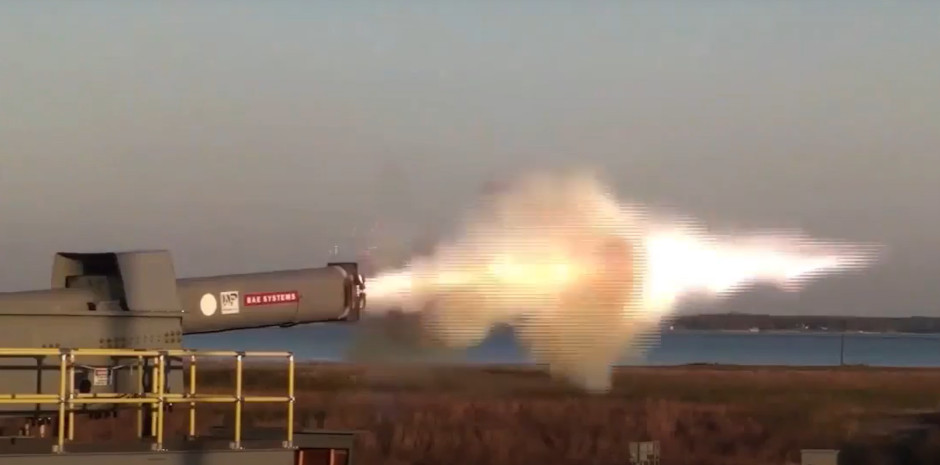
It is an advanced containment technology demonstrator capable of firing hypersonic projectiles. The demonstrator system's muzzle energy is 32 Megajoules (MJs), which is much less than the 16" guns of an Iowa Class battleship (290 MJs). However with the projectiles envisioned, this is enough for a 110 nautical mile range.
Specifications (notional, as published by BAE Systems)
Range: 100 nautical miles
Launch velocity: Mach 7.5
Impact velocity: Mach 5.0
Rate of fire: 10 rounds per minute
BAE Systems have developed a hypervelocity projectile which is compatible with the rail gun. It is 0.6 meters (24 inches) long and weighs 12.7 kg (28 lb):

Chinese Navy: EM Railgun deployed on test ship
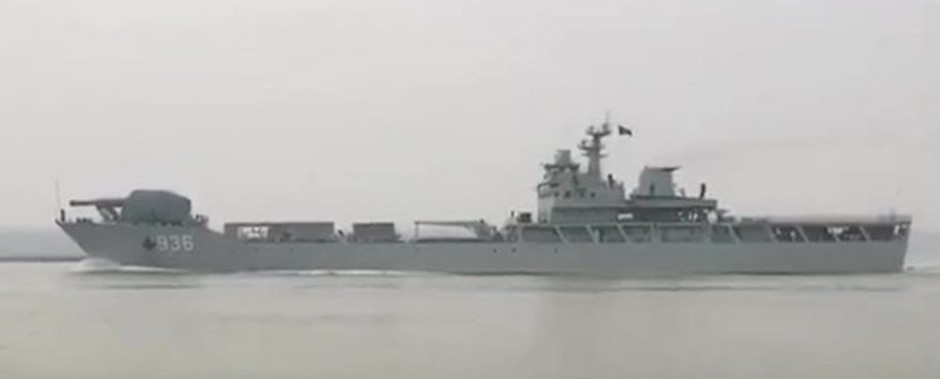
In 2017 the Chinese Navy, formally known as the PLAN (People's liberation Army Navy), put a rail gun on warship for tests. The turreted system was the first such device seen aboard a warship anywhere in the world. The ship, 936 Haiyangshan, is a Type 072III-class landing ship. While landing ships could conceivable be used for indirect fire support, the choice of vessel seems more about convenience than a doctrinal hint.
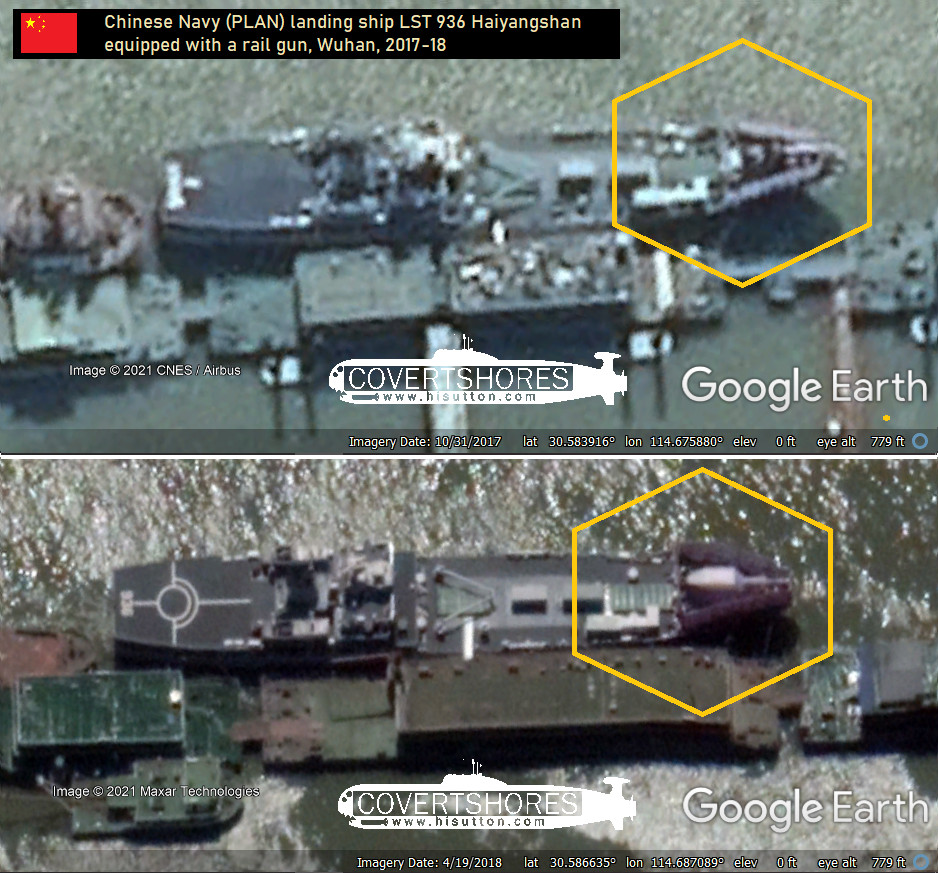
Note the walls around the installation, shielding it from prying eyes.
The necessary generator and equipment systems appear to have been laid out on the spacious deck behind the turret.
Although the overall status of the program is, predictably, unclear, the test vessel now appears to be undergoing modifications in Port Arthur (now Lüshunkou District, Dalian) since November 2020:
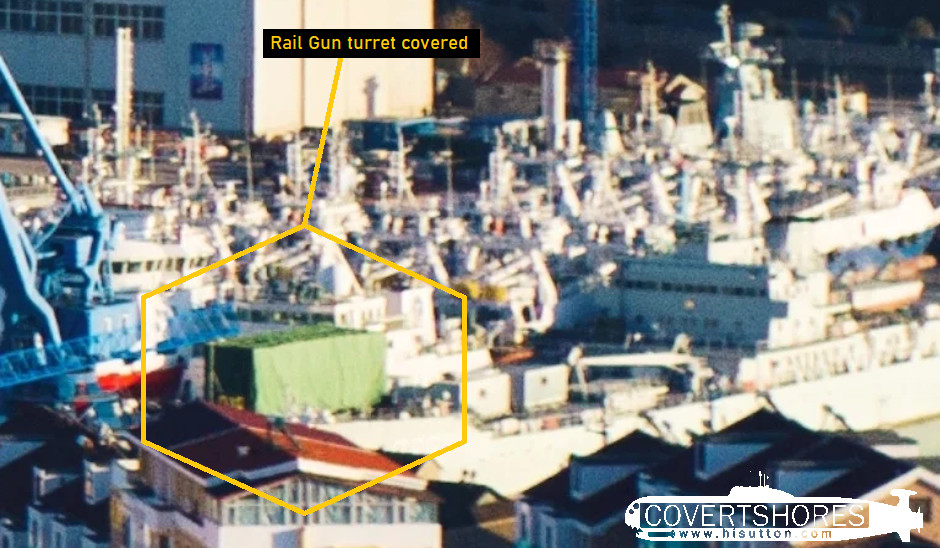
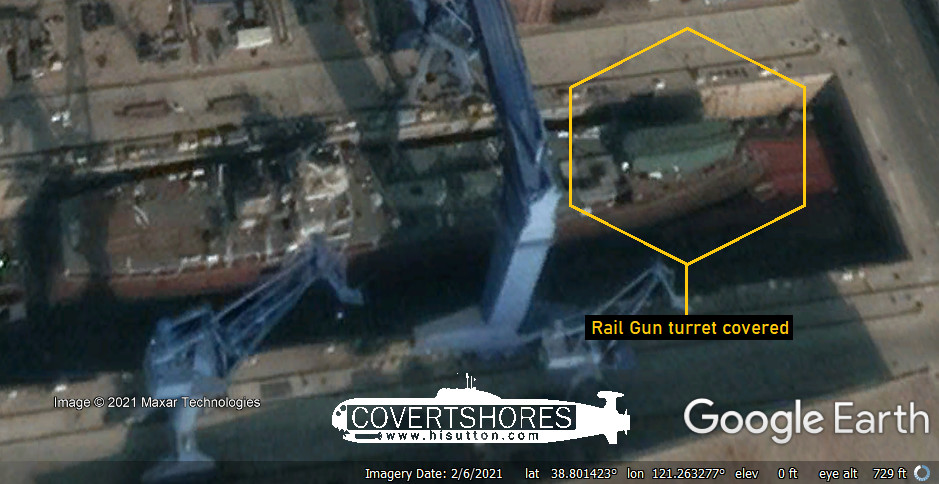
Get The essential guide to World Submarines
This Covert Shores Recognition Guide Covers over 80 classes of submarines including all types currently in service with World Navies.Check it out on Amazon
Blitzer: General Atomics Multi-mission Railgun Weapon Systems
 General Atomics Rail Gun program has largely been associated with the US Army. However their Blitzer system is proposed for warships too. The 10-20 megajoules system offers the same general advantages as the BAE Systems model, albeit in a less powerful package.
General Atomics Rail Gun program has largely been associated with the US Army. However their Blitzer system is proposed for warships too. The 10-20 megajoules system offers the same general advantages as the BAE Systems model, albeit in a less powerful package.
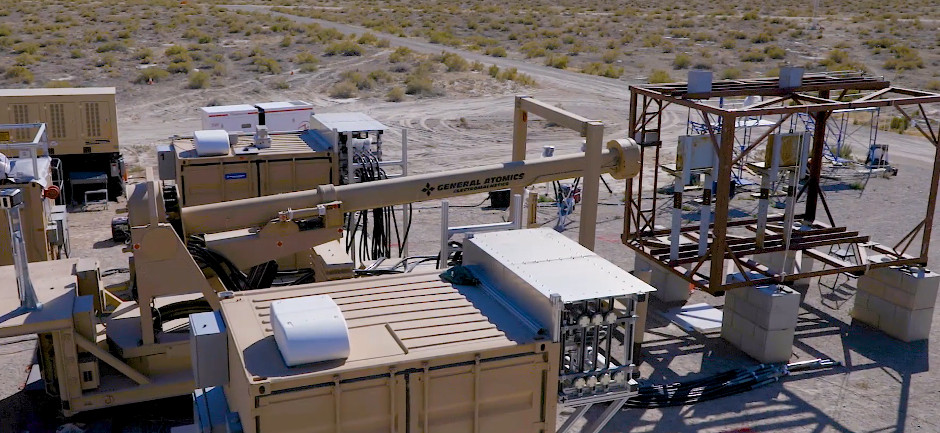
The system has been displayed and tested by the US Navy as part of their research into railguns.
Covert Shores Posters, T-shirts, Mugs
and more featuring exclusive Covert Shores original artworks and design...Available on TeeSpring
This may help cover the overheads of the website
Şahi 209 Block-II
 The Şahi 209 Block-II has been developed by Turkish company Yeteknoloji. The system, which is proposed for both land and sea-based platforms, has a range of about 27 nautical miles. While this is less than the US Navy's project, it is much greater than standard naval guns.
The Şahi 209 Block-II has been developed by Turkish company Yeteknoloji. The system, which is proposed for both land and sea-based platforms, has a range of about 27 nautical miles. While this is less than the US Navy's project, it is much greater than standard naval guns.
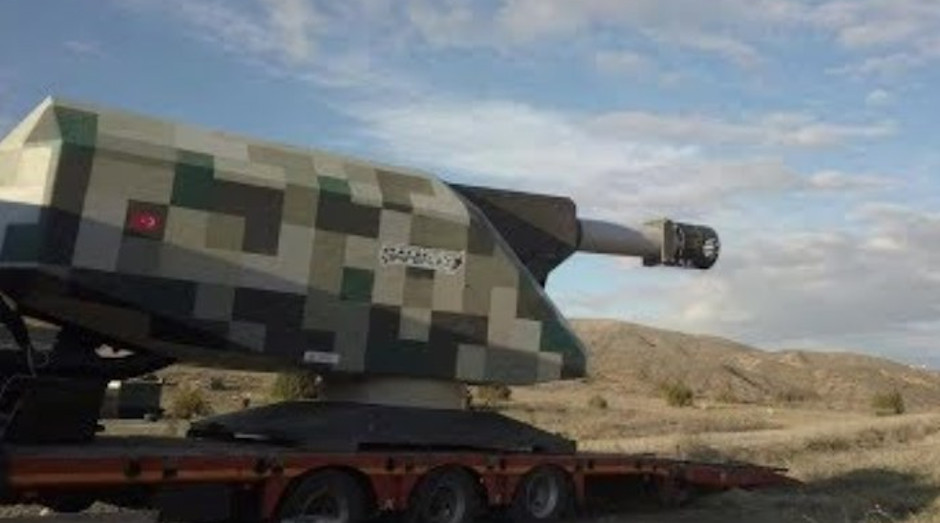
The 7 meter barrel and 10 megajoules pulse system gives the projectile a speed of around Mach 6.
ASELSAN Tufan
 ASELSAN, Turkey's largest defense firm, has developed a electromagnetic (EM) railgun. The focus of the Tufan Electromagnetic Launch System (EMFS) project is for air-defense, as opposed to indirect fire. The system may arm the Turkish Navy's future TF-2000 air defense frigates.
ASELSAN, Turkey's largest defense firm, has developed a electromagnetic (EM) railgun. The focus of the Tufan Electromagnetic Launch System (EMFS) project is for air-defense, as opposed to indirect fire. The system may arm the Turkish Navy's future TF-2000 air defense frigates.
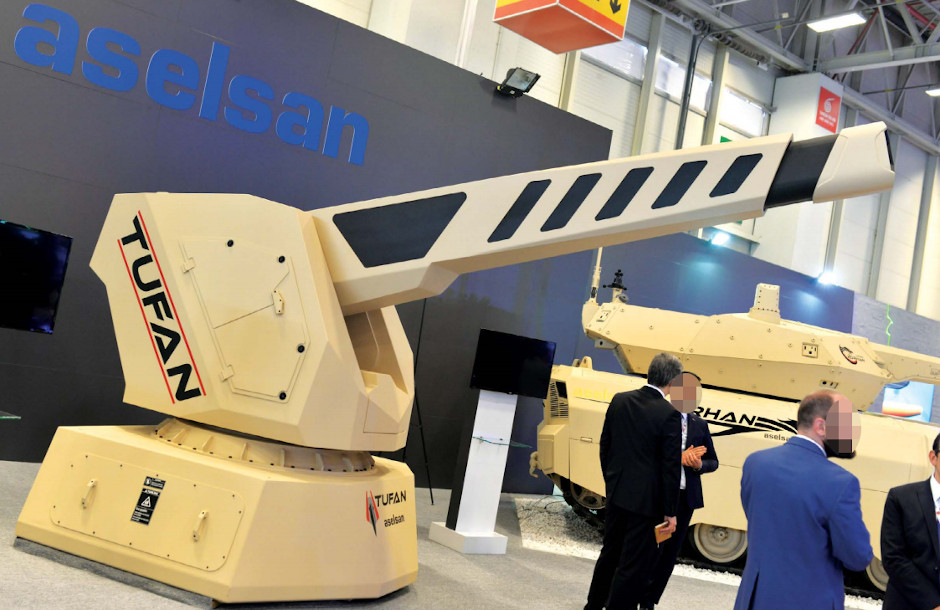
Mock up of a Tufan turret. Photo ASELSAN
Related articles (Full index of popular Covert Shores articles)
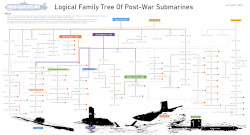 World Submarines Family Tree.
World Submarines Family Tree.




 +
+ 



 Nuclear Missile submarines
Nuclear Missile submarines















 World survey of AIP submarines
World survey of AIP submarines
 Explosive Boats world history
Explosive Boats world history
 Narco Subs 101. w/Cutaway
Narco Subs 101. w/Cutaway













 World guide to Heavyweight Torpedoes
World guide to Heavyweight Torpedoes








 Covert Shores guide to underwater weapons
Covert Shores guide to underwater weapons






